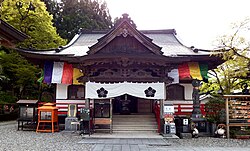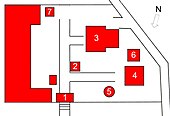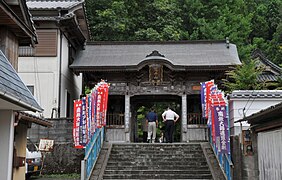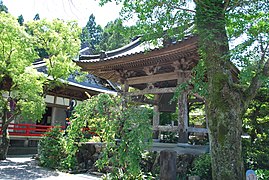Iwamoto-ji
The Iwamoto-ji ( Japanese 岩 本寺 ), with the Go Fujiizan (藤井 山) and Gochiin (五 智 院) in Shimanto (四万 十 町) in the Kōchi prefecture , is a temple of the Chisan branch (智 山 派) of the Shingon Buddhism . In the traditional count it is the 37th temple on the Shikoku pilgrimage route .
history
According to the temple tradition, the temple was built by the priest Gyōki at the request of Emperor Shōmu , 3 km northwest of the shrine for Niida Myōjin ( 仁 井田 明 神 ). The temple was therefore also called "Niidadera". Later, priest Kūkai visited the temple during the Kōnin era (810-824) and divided the shrine into five, where he presented these five for veneration of the Saints Fudō, Kannon and Jizō, as well as the Amida Buddha and the Yakushi Buddha. Kūkai also built five sub-temples. They are called, together with the Fukuenmanji ( 福 圓 満 寺 ) and others, the “12 Fukuji” or the “Five Niida Shrines” ( 仁 井田 五 社 ).
The armed conflicts during the Tenshō era (1573–1592) with their destruction led to the demise of the temple and the shrines. With the reconstruction, the temple - it was still called "Iwamoto-in" back then - came under the control of the shrine. In the 16th century and during the Edo period , the temple was granted to the local princes through territorial allocation and the like. a. Measures supported, but the temple-shrine connection remained. After the Meiji Restoration in 1868, as elsewhere in Japan, the temple and shrine were separated. The Buddhist statues came to the temple, but the temple lost most of its territory. A painstaking reconstruction followed, which continues to this day.
investment
You climb a short flight of stairs to the temple gate (山門, Sammon; 1), then you have the temple bell (鐘楼, Shōrō; 2) on the right side and the main hall (本 堂, Hondō; 3) on the right. The main hall was rebuilt in 1978. The coffers for the ceiling were painted with the help of donations, some with contemporary contemporary themes.
Also on the right-hand side of the complex is the 200-year-old Daishidō (大師 堂; 4), on the right in front of it the small, round metal (聖 天堂, Seitendō; 5) dedicated to the holy Kangiten (歓 喜 天) and on the left the small one Temple to commemorate the founding of the temple, the Kaisandō (開山 堂; 6). On the northern edge of the facility is the small shrine Suites-gū (水 天宮, Suites-gū; 7).
photos
Remarks
- ↑ "Suites" is the Japanese name of the Buddhist water deity Varuna, who was identified with the Shinto deity Ame-no-minaka-nushi.
literature
- Kōchi-ken kotogakko kyoiku kenkyukai rekishi bukai (Ed.): Iwamoto-ji . In: Kōchi-ken no rekishi sampo. Yamakawa Shuppan, 2006, ISBN 978-4-634-24639-3 , page 243.
- Oguri, Doei: Kukai. Shikoku hachijuhachi kosho no arukikata. Chukei no Bunko, 2011, ISBN 978-4-8061-4067-2 .
Web links
Coordinates: 33 ° 12 '28.7 " N , 133 ° 8' 4.6" E
← Previous Temple: Shōryū-ji | Iwamoto-ji | Nearest temple: Kongōfuku-ji →






